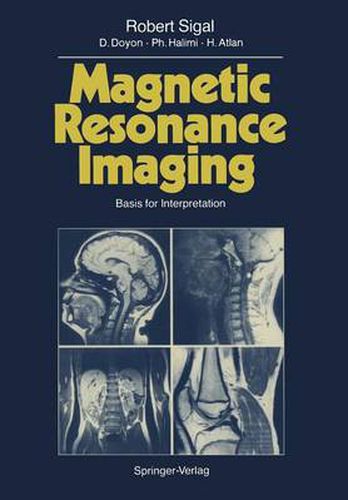Readings Newsletter
Become a Readings Member to make your shopping experience even easier.
Sign in or sign up for free!
You’re not far away from qualifying for FREE standard shipping within Australia
You’ve qualified for FREE standard shipping within Australia
The cart is loading…






This title is printed to order. This book may have been self-published. If so, we cannot guarantee the quality of the content. In the main most books will have gone through the editing process however some may not. We therefore suggest that you be aware of this before ordering this book. If in doubt check either the author or publisher’s details as we are unable to accept any returns unless they are faulty. Please contact us if you have any questions.
Magnetic Resonance Imaging (MRI) is a rapidly evolving technique which is having a significant impact on medical imaging. Only a few years ago, al though Nuclear Magnetic Resonance (NMR) was well known as an important analytical technique in the field of chemical analysis, it was effectively un known in medical circles. Following the initial work of PAUL LAUTERBUR and RAYMOND DAMADIAN in the early 1970s demonstrating that it was possible to use NMR to produce im ages, progress in the medical fields was relatively slow. Recently, however, with the availability of commercial systems, progress has been very rapid, with increasing acceptance of MRI as a basic imaging technique, and the develop ment of exciting new applications. MRI is a relatively complex technique. First, the image depends on many more intrinsic and extrinsic parameters than it does of in techniques like X-ra diography and computed tomography, and secondly, the intrinsic parameters such as T1 and T2 are conceptually complex, involving ideas not usually de scribed in traditional medical imaging courses. In order to produce good MR images efficiently, and to obtain the maximum information from them, it is necessary to appreciate, if not to fully understand, these parameters. Further more, knowledge of how the image is produced helps in appreciating the ori gin of the artifacts sometimes found in MRI due to effects like patient motion and fluid flow.
$9.00 standard shipping within Australia
FREE standard shipping within Australia for orders over $100.00
Express & International shipping calculated at checkout
This title is printed to order. This book may have been self-published. If so, we cannot guarantee the quality of the content. In the main most books will have gone through the editing process however some may not. We therefore suggest that you be aware of this before ordering this book. If in doubt check either the author or publisher’s details as we are unable to accept any returns unless they are faulty. Please contact us if you have any questions.
Magnetic Resonance Imaging (MRI) is a rapidly evolving technique which is having a significant impact on medical imaging. Only a few years ago, al though Nuclear Magnetic Resonance (NMR) was well known as an important analytical technique in the field of chemical analysis, it was effectively un known in medical circles. Following the initial work of PAUL LAUTERBUR and RAYMOND DAMADIAN in the early 1970s demonstrating that it was possible to use NMR to produce im ages, progress in the medical fields was relatively slow. Recently, however, with the availability of commercial systems, progress has been very rapid, with increasing acceptance of MRI as a basic imaging technique, and the develop ment of exciting new applications. MRI is a relatively complex technique. First, the image depends on many more intrinsic and extrinsic parameters than it does of in techniques like X-ra diography and computed tomography, and secondly, the intrinsic parameters such as T1 and T2 are conceptually complex, involving ideas not usually de scribed in traditional medical imaging courses. In order to produce good MR images efficiently, and to obtain the maximum information from them, it is necessary to appreciate, if not to fully understand, these parameters. Further more, knowledge of how the image is produced helps in appreciating the ori gin of the artifacts sometimes found in MRI due to effects like patient motion and fluid flow.